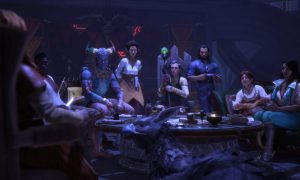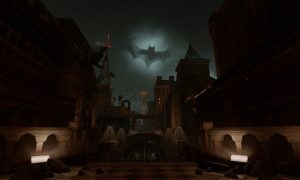
Games with punishing amounts of difficulty have become a full-fledged gaming niche. Whether we’re talking about repeatedly getting blown to pieces in FTL, getting sliced to ribbons in Dark Souls or watching an entire kingdom be reduced to a few gibbering-mad and starving dwarves in Dwarf Fortress, throat-punchingly rough challenge is here to stay – and Rogue Legacy represents the latest advance of this style. Set in a typical swords-and-sorcery setting, this indie game has you playing generation after generation of noble warrior striving to slice his or her way through a dynamically generated castle of pixelated horrors in a quest to rescue the king. Along the way you’ll pass on gold and upgrades to your heirs, unlock new classes, and probably slam your fist on your desk and yell an expletive more than a couple times. If you like old-school graphics and a creative take on the Metroidvania style of gameplay, this is a game you’re going to want to check out.
As is typical with roguelike games – really, it’s practically traditional at this point – the story portion of Rogue Legacy is pretty minimal, so I won’t spend much time on that. There’s a king, he’s in a magical monster-filled castle, he gets hurt, and now it’s up to you to storm into there and set right whatever has actually gone wrong. This bare backdrop leads us into the heart and soul of Rogue Legacy: the prospect of exploring a dynamically generated castle filled with all manner of traps, monsters and challenges. Once again, it’s worth stressing that these are not meager obstacles that you’ll find yourself able to easily elude with a modicum of practice. No, Rogue Legacy is out to kill your character, your character’s kids, THEIR kids, their kids’ kids, and pretty well every successive generation of this uniquely stubborn bloodline until your mountain of dead descendants finally yields a hero who can finish this quest.[singlepic id=14004 w=320 h=240 float=left]
It’s those generations which put the ‘lite’ in the ‘Roguelike-lite’ description of Rogue Legacy. While a typical Roguelike has death being entirely permanent – there is no real ‘reload’ feature in the old-school games like Nethack or Angband, nor will you find one in a similarly challenging game like the aforementioned FTL. But while death finishes your immediate map-exploring in Rogue Legacy, your statistics – as well as the gold you’ve earned up to the moment of your current death – will pass on to your next of kin/next character you control. If you’ve played the Dead Rising series or Demon’s Souls, then you understand what’s going on here: the general goal of every playthrough is to last as long as you can, acquiring as much experience and/or loot as possible, growing incrementally stronger after each of your failures. Rogue Legacy follows this blueprint in spades, to great effect – while also adding a few unique twists on top of it all.
As I mentioned, when your character dies, your chosen offspring gets all the gold you’ve acquired up to that point. This gold can be spent on a wide variety of upgrades – ranging from additional base health and power, to unlocking entire character classes your offspring may randomly become when it’s their turn to run headlong towards their own demise. These upgrades are abstractly represented in a kind of ‘Act Raiser‘-lite style, except instead of developing a populated city, you’re building an increasingly large manor for your descendants to live in, and it’s a very nice bit of polish for what otherwise could have been a simple menu system. In addition to these passive upgrades to stats, you’ll also be able to spend gold buying equipment to use in the castle, as well as enchantments to place on the equipment. All of these upgrades remain available and paid-for no matter how many deaths your characters experience – though the armor and enchantments need to have their recipes discovered first by happening upon particularly nice chests in the castle proper. Saving up is initially impossible – once you decide to enter the castle, you must give up all of your current gold, after which point you’re locked inside until you win the game or die. So, don’t bother being too frugal.[singlepic id=13986 w=320 h=240 float=right]
Speaking of those classes, they’re pretty diverse. Cellar Door Games states that there are nine classes to be found in Rogue Legacy, and I’ve managed to go through the lion’s share of them so far. You have the miner, who is rather weak but gets a bonus to gold discovered – making it perfect for when your goal is to grind the money for one upgrade in particular. There’s the barbarian who’s racked out with physical power, and who gets an explicitly Skyrim styled “FUS RO DAH” shout that affects enemies in a circle around you. Later on you’ll even manage to pick up a lich, whose maximum health increases with every enemy kill – opening up potentially limitless power, so long as you can find a way to actually refill that health of yours. Each of the classes has a fairly different playstyle to them – while there’s not ‘whole new game’ levels of difference between them, they’re different enough that you have to pay attention to each of their particular subtleties. One twist which may frustrate some players is that your offspring will randomly select one of these classes – and each generation only gives you 3 offspring to choose from, so if you’re intent on playing a paladin you may have to wait a few deaths before that opens up for you.
Beyond the statistics and equipment, there are also some other factors that will change your gameplay – and I found these to be the most adorable addition to Rogue Legacy. As mentioned, after each death you get to select which of three randomly generated offspring of yours will be the next to march to their doom. Their sex and class is randomized, as are the secondary spell they get to use (your mainstay move in this game is a very straightforward sword-slash) – along with a few other traits. Color-blind characters will literally have their time in the castle spent in greyscale, while farsighted characters will have everything nearby them appear blurry. There’s a variety of these little quirks, and they’re so fun to discover on their own that I won’t say more than I already have about them. So long as you’re comfortable with having your character in part ‘assembled’ for you, rather than you assembling each detail of your character on every playthrough, you’ll likely appreciate the quirks that you sometimes have to put up with for each new attempt.[singlepic id=13989 w=320 h=240 float=left]
While that gives a good rundown of what options and upgrades are available to you, that still leaves the castle itself to consider. Once again, this is relatively old-school 2D platformer fun that Rogue Legacy offers – think Mega Man or Castlevania, but made vastly more punishing. You’ll spend a lot of time jumping out of the way of bullets and spells, or going up against enemies and watching carefully for the ‘tells’ they give before they strike at you. You’ll also deal with jump puzzles, boss encounters, and a few puzzles – the last largely in the form of the fairy chests that sometimes show up throughout the castle. These chests contain recipes for enchantments that you can place on your equipment at the start of each quest attempt – and they are unique in that they require particular conditions to open them up, ranging from ‘defeat all enemies in the room’ to ‘reach the chest without taking damage’. If you explicitly fail the conditions required, that’s it for the chest on that playthrough – it’s locked and won’t be opening up. While this has the potential to be the most frustrating part of Rogue Legacy, there’s one bit of mercy in play: you can elect to force the castle to keep its previous layout on a new attempt, at the cost of a major reduction in the amount of gold acquired during that playthrough. Perfect for when you care more about another attempt at a coveted fairy chest and are willing to sacrifice some gold rather than risk it getting ‘shuffled’ away, to return only who knows when.
All of the various rooms in the castle are also arranged into four different general area types: the castle proper, the forest, the tower and the dungeon. A boss in each of these areas must be defeated in order to unlock the ‘final’ part of the castle, and as with every other room (save for this ‘final’ portion) in the game, these boss rooms are randomly shuffled about each playthrough. On the bright side, once you defeat the boss of a section, their death seems permanently locked in for the purposes of advancing the story – so there’s no need to have to kill all four bosses in this high-difficulty game on a single castle run. There’s a good amount of variety between each of these areas, both in terms of general environment art and monsters/traps you’ll encounter – though the variety of monsters in each area felt a little on the thin side. As Rogue Legacy’s Steam store page says, “Over 60 different enemies to test your skills against. Hope you like palette swaps!” Hey, points for honesty – the lack of variety is a minor flaw in an otherwise very solid game.[singlepic id=13990 w=320 h=240 float=right]
Rogue Legacy is one of the shiniest gems to come out of the Steam Greenlight program – it really does a fantastic job of mixing the better parts of a Roguelike experience with a solid 2D platformer, with a whole lot of polish on top of it all. If you’re curious but not totally sold yet, keep in mind that there’s a PC demo available for Rogue Legacy that does a grand job of showing off the type of game it is. Those of you who are more in the ‘skip the demo, I HAVE to have this’ – well, first off, I know that feeling well. It’s available now for $14.99 USD right in the Steam store. Whether you’re trying the full game or the demo, I wish you good luck, have fun, and be sure to stream your attempts online if you’ve got the rig and connection to do so. Your friends will get a kick out of your growls of frustration.
Victor Grunn has been a gamer since the days of single-button joysticks and the Atari 800XL. When not lamenting the loss of the Ultima series or setting people on fire in Team Fortress 2, he's an aspiring indie game developer and freelance writer.

See below for our list of partners and affiliates:

























